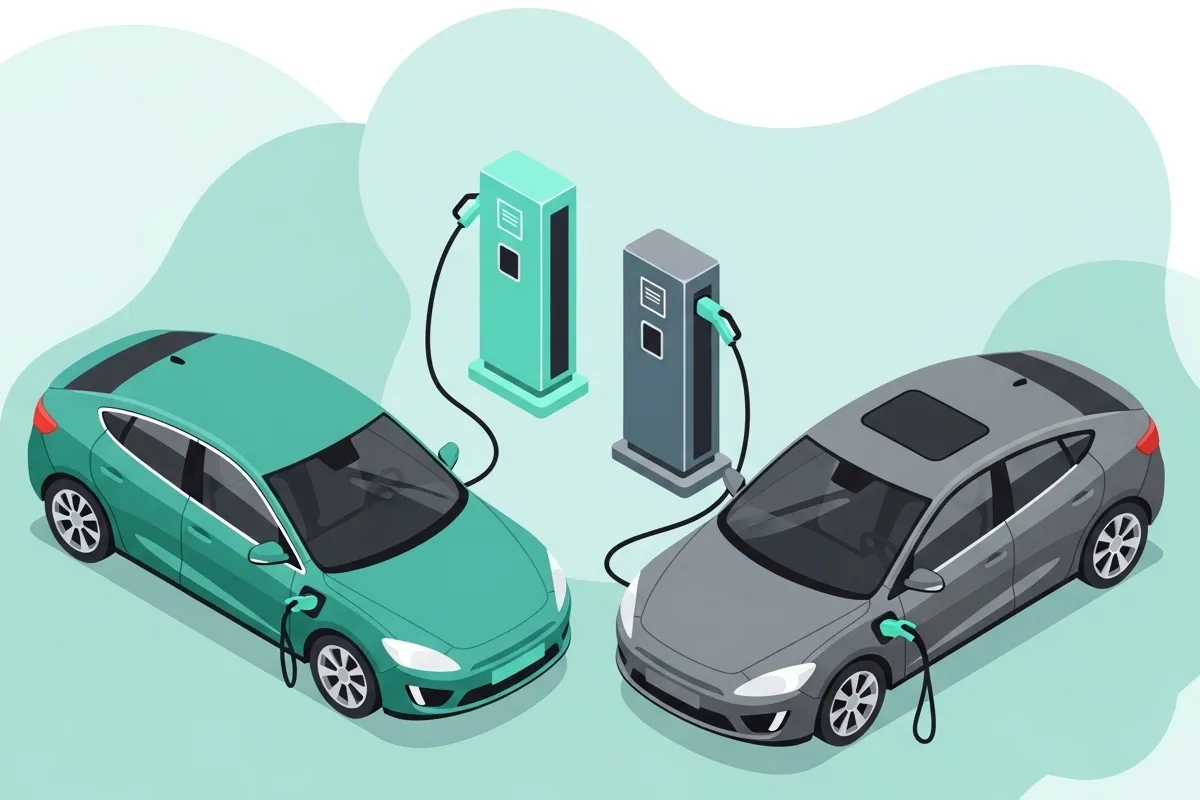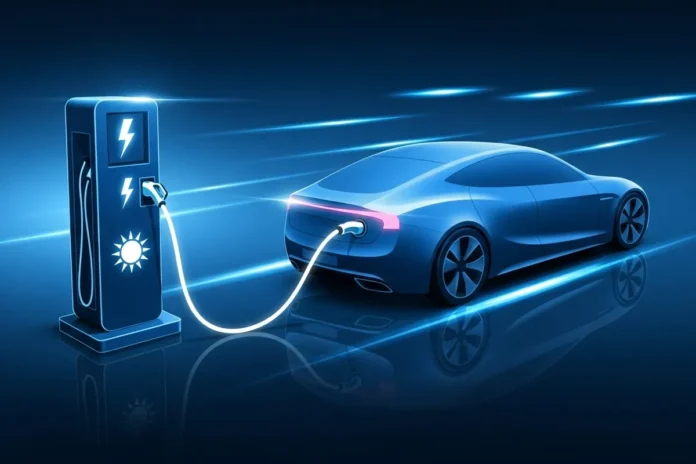India’s automotive landscape is undergoing a significant transformation, with electric vehicles (EVs) outpacing hybrid cars in sales growth. This shift, driven by favorable government policies, an expanding range of EV models, and growing consumer demand for sustainable transportation, positions India as a key player in the global transition to electric mobility. As the world intensifies efforts to combat climate change, India’s embrace of EVs reflects both environmental and economic priorities, aiming to reduce carbon emissions and dependence on fossil fuels.
EV Sales Growth: A Milestone Achievement
Recent data highlights the accelerating adoption of EVs in India. Between January and May 2025, EV sales grew by an impressive 4.4%, while hybrid car sales remained nearly stagnant at 2.5%, down from 2.4% in the same period the previous year. For the financial year 2025 (FY25), EV sales, including SUVs and multi-purpose vehicles (MPVs), reached a historic milestone, surpassing 100,000 units for the first time with a total of 107,541 units sold. This represents an 18% increase from the 91,320 units sold in FY24. In contrast, hybrid car sales for FY25 stood at approximately 82,700 units, underscoring the widening gap between the two segments.
This growth in EV sales is not merely a statistical achievement but a reflection of changing consumer preferences and supportive market conditions. The milestone of crossing 100,000 units in a single financial year signals strong market confidence in EVs and sets a foundation for further expansion.
A Diverse EV Market Fuels Consumer Choice
One of the key factors behind the EV surge is the increasing diversity of models available to Indian consumers. Approximately 20 EV models are now offered by leading manufacturers, including Hyundai, JSW MG Motor, Kia, Mahindra & Mahindra, Tata Motors, Citroen, and BYD. These models span a range of price points and vehicle types, from compact hatchbacks to premium electric SUVs, catering to diverse consumer needs and budgets.
In contrast, the hybrid car market remains limited, with only three major players—Honda, Maruti Suzuki, and Toyota—offering models. This lack of variety may be constraining hybrid growth, as consumers increasingly gravitate toward the broader selection and innovative features of EVs. For example, Tata Motors has gained significant traction with models like the Nexon EV, while Hyundai’s Creta Electric has attracted attention for its blend of performance and practicality.

Government Policies: A Catalyst for EV Adoption
Government policies are playing a pivotal role in driving EV adoption. At the national level, EVs benefit from a Goods and Services Tax (GST) rate of just 5%, significantly lower than the 43% imposed on hybrid vehicles. This tax advantage reduces the upfront cost of EVs, making them more competitive in a price-sensitive market like India.
Additionally, several states have introduced incentives to further encourage EV purchases. States such as Uttar Pradesh have waived registration costs for EVs, while also extending this benefit to hybrids, a move that has sparked debate within the industry. Other states, including Karnataka, are considering similar waivers to promote cleaner transportation options. These state-level incentives complement national policies, creating a robust framework for EV growth.
The Indian government’s broader vision for electric mobility is articulated through initiatives like the National Mission on Transformative Mobility and Battery Storage, led by Niti Aayog . This mission aims to localize EV production and develop a sustainable mobility ecosystem, aligning with India’s “Make in India” strategy.
Industry Perspectives: A Debate Over Incentives
The policy landscape has not been without controversy. While companies like Maruti Suzuki and Toyota, which have a strong presence in the hybrid market, support incentives for hybrids, pure-EV manufacturers such as Mahindra & Mahindra and Tata Motors have expressed concerns. These companies argue that incentives for hybrids could undermine the government’s ambitious target of achieving 30% EV penetration by 2030. They emphasize that prioritizing EVs is essential for meeting India’s long-term environmental and economic goals.
Niti Aayog has weighed in on this debate, highlighting the environmental superiority of EVs. Unlike hybrids, which rely on a combination of internal combustion engines and electric motors, EVs produce zero tailpipe emissions, making them a critical tool for reducing India’s carbon footprint. This perspective is particularly relevant as India strives to meet its commitments under the Paris Agreement and address urban air pollution.
Infrastructure and Innovation: Building Consumer Confidence
The growth of EVs is also supported by improvements in charging infrastructure and manufacturer innovation. Hyundai Motor India, a key player in the EV market, has been proactive in addressing consumer concerns about charging availability. Tarun Garg, Chief Operating Officer of Hyundai Motor India, noted that increasing consumer confidence is driven by clearer government policies and the expansion of charging networks. Hyundai has launched models like the Creta Electric and plans to install 600 fast DC chargers across India by 2032, with 89 already operational. Additionally, the company is providing 11 KW AC home chargers with the Creta Electric, making home charging more accessible.
Other manufacturers are also contributing to infrastructure development. For example, the Ministry of Heavy Industries’ Scheme to Promote Manufacturing of Electric Passenger Cars in India encourages investments in EV production and charging infrastructure, fostering a supportive ecosystem for growth.
Global Context: India’s Role in Electric Mobility
India’s EV surge is part of a broader global shift toward electric mobility. Countries like the European Union, which aims for all new cars to be zero-emission by 2035, and China, the world’s largest EV market, are setting the pace for global adoption. India’s efforts align with these trends, positioning the country as a significant player in the future of sustainable transportation. Reports like those available on the e-AMRIT portal highlight India’s progress and potential in electric mobility, emphasizing the role of policy and innovation.
Challenges and Opportunities Ahead
Despite the promising growth, challenges remain. The development of charging infrastructure, particularly in rural and semi-urban areas, is critical for widespread EV adoption. While urban centers are seeing rapid expansion of charging stations, rural areas lag behind, limiting the appeal of EVs for some consumers. Additionally, the total cost of ownership, including the initial purchase price and maintenance, must remain competitive with traditional internal combustion engine vehicles.
However, these challenges also present opportunities. Continued investment in charging infrastructure, advancements in battery technology, and economies of scale are expected to drive down costs, making EVs even more accessible. The government’s focus on localizing EV production, as outlined in initiatives like the Faster Adoption and Manufacturing of Electric Vehicles (FAME) scheme, will further strengthen India’s EV ecosystem.
Conclusion: A Bright Future for EVs in India
The rapid rise of EV sales in India, outpacing hybrid growth, underscores the effectiveness of government policies and the market’s response to sustainable transportation options. With a growing range of models, improving infrastructure, and strong policy support, EVs are poised to play a central role in India’s automotive future. As the country continues to innovate and invest in electric mobility, it is well on its way to achieving its environmental and economic goals, paving the way for a cleaner, greener future.
Policy Comparison Table
| Vehicle Type | GST Rate | Registration Cost Incentives |
|---|---|---|
| EVs | 5% | Zero in several states |
| Hybrids | 43% | Waived in Uttar Pradesh |




